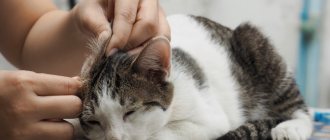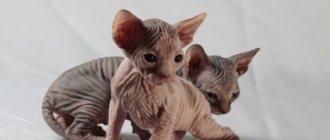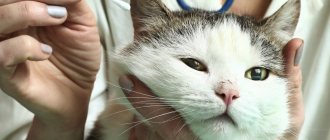Description of the main reasons
Not all owners manage to detect sores on their cat’s back in time. In many cases, the problem is discovered when the animal develops characteristic symptoms that are very difficult to ignore. We are talking about focal hair loss, severe redness of the skin, peeling, terrible itching and the appearance of large scratches due to it. And even then, the owners are in no hurry to visit a dermatologist, hoping that everything will go away on its own. Unfortunately, it does not always go away and the pet is delivered not only with large sores on the back, but also with deep scratches and open wounds. The veterinarian, based on the existing clinical picture, will rule out the most likely options:
- Flea dermatitis. A fairly common problem in cats of all breeds, regardless of whether they go outside or not. Parasites can get onto an animal's fur from the clothes or soles of shoes of its owner or his guests. In some cases, a single flea bite is enough to provoke a severe allergic reaction to substances contained in the parasite's saliva. The flea version is also considered if there are many sores on the back, which are accompanied by severe itching. The cat behaves restlessly; you can notice how it begins to itch more often, and at times bites into its skin. Redness of the skin and slight flaking appear under the fur. White and black specks in an animal's fur can also be a symptom of the presence of parasites. The best option would be regular antiparasitic treatment, especially during peak insect activity (spring - summer). The same drugs are used for treatment as for prevention (Frontline, Stronghold, Advocate, Advantage).
- Food allergies. A real nightmare for many decorative breed cats. In each case, it always manifests itself differently, but there are common symptoms - severe itching, redness and flaking of the skin. If along with this sores appear on the back, then it is necessary to exclude the possibility of developing a food allergy. It’s good if all the symptoms appeared after changing the food. Then it is easier to identify a potential allergen and eliminate it from your diet. It is worse when new products have not recently been introduced into the animal’s diet and the brand or type of food has not been changed. In most cases, food allergies haunt the pet throughout its life. Constant exacerbations will become constant companions in life if you do not accurately determine the substance or product that causes an allergic reaction in the cat. In some cases it may be chicken, while others may have dairy intolerance. In breeds such as the Sphynx, Maine Coon, Abyssinians, Britons and exotics, the selection of food requires increased attention. And this process does not always go smoothly. There are also hair loss and allergic itching, and various papules appear throughout the body.
- Insect bites. Red sores on a cat's back can appear after bites from flies, gadflies, ants, bees and wasps. Especially for pets who live or have free access to the street. In rare cases, the bites of these insects can pose a danger to the life of the animal. This can happen after a stinging insect bites the animal’s neck, larynx or tongue. Severe swelling can lead to suffocation. Just in case, even after a bite in the paw or ear, you can give your cat an antihistamine for an anti-inflammatory effect.
- Bacterial damage. Because of it, the cat may also develop sores on the back, which will bleed and fester. Their appearance can be triggered by an infection, which usually gets into the wounds after scratching (in diseases accompanied by severe itching) or injuries received during play or fights with other animals. To make a diagnosis, deep plucking and fluid from the lesions will be required, which will be sent for cytological examination. After identifying the pathogen, effective antibacterial and anti-inflammatory drugs are selected.
Allergic skin diseases
There is a whole spectrum of skin diseases that are diverse in nature and manifest themselves in completely different ways. Skin lesions can be caused by a variety of reasons - hereditary, anthropogenic, infectious; even a simple change in diet can cause rashes on the body.
Some types of skin diseases are subtle, which can cause your pet to suffer for a long time. In order to prescribe appropriate treatment in a timely manner, you should familiarize yourself with the main clinical signs of some skin ailments.
Allergic reactions are a consequence of an inadequate response of the cat's immune system to foreign substances entering the body. The cause of an allergy can be anything: a certain component of food, household chemicals, plant pollen, synthetic fabrics, dust in the house, etc. When exposed to an allergen, skin hyperemia, inflamed areas, severe itching, hair loss and increased body temperature are observed.
We invite you to read: How to make a cat door with your own hands: features of using the accessory
Important. Long-term exposure to an allergen is fraught with the development of atopic dermatitis, eosinophilic granuloma and asthmatic syndrome.
Therapy for allergic reactions includes taking antihistamines to relieve itching, hormonal agents and antibiotics if urgently needed. To alleviate the pet's condition, medicated shampoos and decoctions of medicinal herbs are used.
List and description of possible causes
The appearance of scabs along the ridge always indicates the development of one of the following diseases in a cat:
The most common reason why cats develop scabs under their fur is redness, swelling, flaking, severe itching, and hair loss all over the body. Food allergies almost always manifest themselves acutely immediately after the irritant enters the body.
Within 1-2 days, all symptoms appear and if left untreated, the acute form can transform into chronic. This means that from time to time the pet will exhibit all the symptoms described above with varying intensities.
Another common cause of scabs on a cat's back can be flea dermatitis. An allergic reaction to flea bites or saliva.
They can become real torture for a cat if the owner ignores regular treatments for parasites. In 90% of cases, scabs under the fur on the back appear as a result of an allergic reaction to flea saliva.
The problem is successfully eliminated with the help of modern drugs Stronghold, Frontline, Advantage, Advocate, etc. A prerequisite is the treatment of all animals living in the house. It also doesn’t hurt to disinfect the premises if the parasites get to your pet from the outside.
A fungal infection of the skin that is particularly contagious and can be contagious to humans. Often found in homeless animals. You can become infected after close contact with an affected pet or through fungal spores getting into the fur.
The clinical picture, although it has its own characteristics, always proceeds differently. Distinctive areas include characteristic crusts under the fur, similar to dandruff or flaking. As the process progresses, a bald spot appears in this area. In severe cases, the area begins to become wet and bleed.
Itching is present in every second case. Diagnosis of lichen is also not simple, since it must be distinguished from flea dermatitis and parasites. This may require illumination of the lesions under a Wood's lamp, microscopic examination of hairs and pieces of skin taken from the plaques.
If doubts arise after this, then a fungal culture taken from the crusts is sown. The result becomes known in 7-10 days. Only after determining the fungal culture can effective drugs be selected for treatment. In 90% of cases, the causative agent is dermatophytes, the rest is due to yeast and mold fungi.
The treatment itself is long-term, using local treatments of the affected areas (Zalain) and taking antifungal drugs (Terbinafine) orally. The use of special shampoos (Nizoral) during bathing also showed good effectiveness. Particular attention is paid to disinfecting the home, since fungal spores can survive up to 18 months in the environment.
To avoid relapses, be sure to carry out wet cleaning with solutions of chlorhexidine, miramistin and bleach added to the water. All woolen items and fabrics that an infected animal comes into contact with are treated with a steam generator.
It often appears on the back in the form of dry crusts. It may occur against the background of an allergic reaction or fungal infection. Along with the crusts under the fur, you can see redness and slight swelling of the skin.
In case of a bacterial infection, the underlying disease is always taken under control. Otherwise, re-inflammation is only a matter of time.
Steroid ointments Akriderm or Triderm can be used as treatment. Using them without a prescription from a veterinarian, who will determine the required dosage, is dangerous for the pet’s health.
Very common along the spine. At the initial stage it appears in the form of small black rashes, which transform into dry crusts over the course of the process. Itching is practically absent, but a bald patch appears at the site of the lesion.
Often found in kittens; in adults, the activity of the subcutaneous mite can provoke serious diseases of the internal organs or tumor processes. Do not forget that demodicosis is not contagious and is not dangerous for other animals or humans.
Single lesions can go away on their own. When the process spreads throughout the body, they search for and eliminate the underlying disease that provoked the activity of the tick.
Ringworm
Ringworm is an infectious fungal pathology that often affects young animals with reduced immunity, as well as cats that have suffered from cancer or viral diseases.
The cause of the disease is fungal spores, which can be carried on clothes or shoes. Infection occurs through contact with a sick animal, through shared toys, feeding and care items.
Clinical signs of ringworm are:
- bald areas on the head, tail and limbs;
- in the center of the affected area, the skin turns red and peels, sometimes ulcers, white scales and crusts appear.
Treatment of the disease is carried out using antifungal ointments and antiseptic solutions. In severe cases, antibiotics, vaccines and oral antifungal medications are prescribed.
Acne is an acne disease characterized by the formation of closed and open comedones, most often on the chin.
The reasons for the development of acne can be improper care of the cat, stress, infectious pathologies, abnormal development of the sebaceous glands and hair follicles. Visually, the disease is manifested by the presence of black or white spots, partial hair loss, and an increase in hard crusts. Acne can progress to painful ulcers and ulcers, which can cause inflammation and bacterial infection.
Treatment of acne consists of treating with antiseptic and antiseborrheic soaps and shampoos (for example, tar), applying antiseptic solutions (Chlorhexidine, Miramistin, etc.). In advanced cases, antibiotics and corticosteroids are used.
This may be a consequence of the activity of several types of parasites. In this case, bald spots form, which turn red and itch. Therefore, when diagnosing miliary dermatitis, it is recommended to submit a piece of skin and fur for analysis. The sample is placed in a nutrient medium that stimulates the growth of the fungus. For effective treatment, special medications are used that remove the cause of itching.
One of the reasons that your cat has patches of baldness on his back may be the previously discussed lichen, which is what the next video is about!
Sorry, there are no surveys available at this time.
Photo of a cat with scabs on its back
Separately, I would like to remind you that vaccination against lichen is ineffective, so you should not torment your pet with unnecessary vaccinations.
If a cat has sores on its back, what it is should be determined by a veterinarian. The diagnosis is made based on the totality of the observed symptoms. It is important to start treating your pet in a timely manner and follow all the specialist’s recommendations.
- What does a skin sore look like in cats?
- The main reasons for the appearance
- Allergy to flea bites or food
- Skin diseases and bacterial infections
- Cat acne
- Reaction to stress
- Insect bites
- External symptoms: cat behavior
- Diagnosis of causes
- General treatment tips
What actions should I take?
Sores on the back along the cat’s spine (as well as in other places) cannot be ignored. The animal needs help. It all depends on the reason.
If the owner is sure that the cat is being attacked by parasites, and the sores are caused precisely by their bites, the animal should be treated for fleas. Today there are enough products on sale that will help quickly solve the problem. The wounds themselves can be treated with an antiseptic to prevent infection and speed up the healing process.
If you suspect that skin problems are the result of an allergy, you can try to review your pet's diet. However, it is not always possible to guess which product caused the reaction, and time passes, and the cat needs to be treated. Therefore, it is better not to take risks, but to immediately show the animal to a veterinarian. He will take tests, determine the irritant and tell you how to deal with the cause of the sore.
This also applies to other situations where the lesion on the back is similar to lichen or demodicosis. You should not engage in amateur activities. Professional diagnosis is required, and then serious treatment. It often involves taking antifungal, anti-inflammatory, and antibacterial drugs.
Only competent advice from a specialist, complex therapy and the caring hands of the owner can quickly alleviate the cat’s condition and eliminate sores without consequences.
What does a skin sore look like in cats?
The external features of the sores vary depending on the diagnosis. Scabs and dry crusts that form during wound healing may be observed on the cat's body. They are often small in size.
Pustules, small, hard, red nodules, may also be present. Their number varies from 1 to several dozen. They can be located not only on the back, but also on the neck of the animal, near the tail.
Often hair begins to fall out next to the scabs. If the itching is too severe, the cat may scratch the affected area of the body. Redness on the skin is possible.
Bacterial infections
Bacterial infections occur in two forms: dry and wet. In the first case, dense formations and crusts appear on the skin. The second form is characterized by the presence of areas of skin with severe hyperemia and moisture, which is accompanied by a rash, ulcers, itching and crusts.
We invite you to read: Why cats love valerian - the answer will surprise you!
To understand the form of the disease in your pet, you need to not only read the description of the disease, but also carefully study the photo.
There can be a huge number of reasons for a bacterial infection:
- allergies accompanied by itching;
- heredity;
- stress;
- violation of metabolic processes;
- presence of shallow wounds;
- diabetes mellitus, tumors, kidney damage, etc.
Treatment is based on the use of antibiotics and local drugs (Miramistin, Levomekol, aluminum and zinc-containing ointments).
Bacterial skin diseases include feline pyoderma.
The main reasons for the appearance
The most common reasons for the appearance of formations on a pet’s body are:
- parasite bites (fleas and ticks);
- allergic reactions;
- infectious processes on the skin;
- reactions to severe stress (for example, moving or getting another pet).
Most often, pustules are observed in cats with increased sensitivity to flea bites. An allergic reaction can be caused by insect saliva. Rashes appear only at the sites of bites.
Most often they can be found in the area of the tail, neck, and chin. The size of the wounds is 0.3-1 cm. Often the kitten begins to scratch the affected areas, which leads to bleeding.
Treatment consists of removing parasites. Not only the animal itself should be treated, but also its things: bed, toys, scratching post. All surfaces in the room to which the cat has access are also treated.
The cause of scabs can also be an allergy to food. The rashes are localized on the head and neck. Partial hair loss, vomiting, and stool disturbances are possible. The pet licks the affected areas. The reaction should not be seasonal.
By changing the food or eliminating the product that caused the adverse reaction from the diet, the symptoms will quickly disappear. Treatment is changing your diet.
With contact dermatitis, the rash occurs in areas with the least amount of fur: the ears, paws, and underbelly. It is a reaction to any irritant: a plant, cosmetics, medicine. When the allergen is eliminated, after a course of taking antihistamines, the sores will disappear.
Ringworm is manifested by the formation of round plaques on the skin. In their place, hair falls out and the skin is very itchy. It should be treated with special shampoos and medications. All other animals will also have to be processed. People should be careful when coming into contact with an infected cat.
Scabies mites can cause scabies. With this pathology, plaques are localized in the cat on the neck and head. Left untreated, the lesions will spread throughout the animal's body.
Demodicosis is a pathology caused by microorganisms. This disease often affects animals with weakened immune systems. It is difficult to treat and relapses are possible. The sick animal will have to be isolated until the course of therapy is completed.
Eczema is seasonal, manifesting itself in spring and autumn. It requires complex treatment: the use of special medications, diet correction, and avoidance of stressful situations.
Possible dermatophytosis. This pathology is caused by fungi. The disease can manifest itself in different ways, depending on the type of fungus. Rashes in the form of papules, scabs, and crusts are possible. To select medications, the veterinarian must determine the type of pathogen using histological examination.
Follicles are caused by staphylococci that have entered the animal's body.] The use of antibacterial drugs and immunostimulants is necessary.
Acne and comedones appear on your pet's chin. The inflammatory process is accompanied by itching. It is required to maintain hygiene, regularly clean the cat's bowls and the affected area. If the cat dishes are made of plastic, you need to replace them with ceramic or metal ones.
Most often, rashes are found along the spine and ridge. Manifestations can be different: licking the back, refusal to eat, attempts to shit in places not intended for this are possible.
The reaction can occur due to any sudden changes in lifestyle: moving, the appearance of a new person or animal, illness.
This problem is especially common in cats that are walked. The bites cause itching. The cat may scratch or lick the affected area. The number of sores is small, the location can be any. It is recommended to use Benadryl for treatment, which reduces discomfort and itching.
Skin parasites
One of the causes of skin rashes is the presence of ectoparasites, among which fleas are the most common. During the bite, they inject saliva into the resulting wound, which provokes itchy skin. The animal begins to scratch the bite site, bringing the infection inside, which causes an inflammatory process. His hair begins to fall out, his skin turns red and becomes covered with wounds.
For treatment, it is necessary to treat the animal’s fur with antiparasitic drugs, as well as disinfect the pet’s habitat. To relieve itching, antihistamines and hormonal agents are prescribed.
Attention. We should not forget that fleas are carriers of helminths and can infect an animal through a regular bite. Therefore, along with treatment for fleas, the animal should be dewormed in a timely manner.
Indeed, it often happens that insects choose the neck as their favorite area for life. Therefore, the cat intensively scratches these places with its claws. As a result, if action is not taken, things will take a bad turn. Itching provokes scratching, and small sores appear on the cat’s neck.
What should the owner do? Examine the animal. If he has fleas, then their locations should be visible on the neck and near the tail. Adult insects and their eggs can be found. In this case, you need to treat the animal for insects, and then treat the wounds. You can use a special collar or drops on the withers. Once the source of the itching is eliminated, it will be much more effective.
External symptoms: cat behavior
To make a correct diagnosis, you need to observe changes in the pet's behavior. Cats may become restless and irritable if they suffer from ticks and insects.
Infectious pathologies often cause lethargy and apathy, refusal to eat, and play with their owners. In addition, most often sores cause physical discomfort to the pet, which leads to the need to scratch or intensively lick the affected area.
We invite you to watch this video:
Diagnosis of causes
It is not recommended to make a diagnosis yourself. It is necessary to show the cat to the veterinarian. First, the specialist will perform an external examination of the sick animal, after which he will interview the owners about any additional symptoms observed.
The doctor can clarify whether there is a connection between the appearance of symptoms and the time of year, whether the onset of sores was preceded by sudden changes in lifestyle, whether the food has changed, whether the animal has taken medications (including anti-parasitic drugs), and whether vaccinations have recently been given.
Diagnostic tests will be performed if necessary. If ringworm is suspected, an ultraviolet lamp is used. The presence of parasites and fungi is checked using skin scrapings. A number of infectious pathologies are confirmed by biopsy results. If a food allergy is suspected, the animal will be placed on a hypoallergenic diet.
Diagnosis and treatment
Sores in the back, and in particular the spine, are not recommended to be ignored. Thus, the owner of the animal must consult a veterinarian if any suspicious spots or crusts are detected on the body. Depending on the cause of the scab, the doctor will prescribe a therapeutic course taking into account individual characteristics.
To make an accurate diagnosis, the veterinarian prescribes a series of tests. The main ones are:
- general blood analysis;
- blood chemistry;
- examination of the affected areas of the skin under a special lamp (necessary if dermatophytosis is suspected);
- scraping from the affected areas for bacterial culture on nutrient media;
- biopsy (if a skin tumor is suspected in a cat).
If the cause of scabs along the spine is ectoparasites, special drugs are prescribed to destroy the parasites. The dosage and type of drug are prescribed by the attending physician. The resulting wound surfaces are treated with an antibacterial agent, which makes it possible to increase the process of skin regeneration and avoid the introduction of secondary microflora.
Scabs that arise due to an allergic type reaction must be treated comprehensively. First of all, it is necessary to identify the cause of the allergy.
If there is a food allergy, then suspicious ingredients are removed from the animal’s diet. If necessary, the doctor will prescribe and conduct special tests for allergens and prescribe adequate treatment. After identifying and eliminating the foreign protein component, new wounds on the skin will stop appearing, and old ones will disappear.
Veterinarians insist not to self-medicate at home. Self-prescribing medications without knowing the exact cause of the appearance of wounds and scabs on the skin can lead to dire consequences and even death (in case of drug overdose).
As a rule, treatment of scabs on the skin includes the use of antifungal agents, as well as medications that relieve inflammation. Demodectic mange diagnosed in a cat requires a special approach. A sick animal must be isolated from other cats and dogs, and the affected part of the coat must be cut off. Next, the skin is washed using special shampoos and aversictin ointment is applied. It is possible to use sulfur ointment and drops.
General treatment tips
You cannot select medications and dosages on your own. The choice should be made by a veterinarian, taking into account the diagnosis and individual characteristics of the cat. Before contacting a veterinarian, Miramistin is allowed to be used. This broad-spectrum drug rarely causes unwanted reactions or complications.
Be sure to complete the course of treatment to the end. If you stop using medications at the first improvement, the disease may recur and become chronic. It will be necessary to take more aggressive medications to cure the cat, both to alleviate the symptoms and to eliminate the cause of the disease.
You cannot refuse treatment. Since the sores cause severe discomfort to the cat, she can scratch them, violating the integrity of the skin. This increases the risk of infection entering the wounds. Purulent complications are possible.
During treatment, medications should not be given without the permission of the veterinarian. Before giving your cat any drug, including dewormers, you need to check its compatibility with the medications used for treatment.
A sick animal should also not be vaccinated: due to a weakened immune system, the reaction can be unpredictable and complications are possible.
Many pathologies are transmitted to people, so owners should follow safety rules when treating a cat so as not to become infected. In some cases, the veterinarian recommends preventative treatment for family members. Do not neglect such recommendations. There is no need to walk a sick cat, as it can easily infect other animals. The risk of complications will also increase on the street.
Cat owners are upset by the appearance of crusts on the back of their pet. Why is this happening? How to help a cat on your own? What means should I use?
Are cat scabs dangerous to humans? In what cases can you not do without veterinary care? This article answers the questions raised.
- Causes
- Allergic reaction
- Ectoparasites
- Subcutaneous mites
- Lichen
- Ringworm
- Pityriasis rosea
- Eczema
- Conclusion
List of skin diseases in cats
If a cat has blood sores on its neck, then you need to think about what this might be connected with. Perhaps you recently introduced a new food into your diet, underwent a course of treatment, or purchased a vitamin complex. Then an allergic reaction cannot be ruled out. Only a doctor can make such a diagnosis, because the symptoms are too vague. Itching, hair loss and scratching can indicate dozens of reasons, including diseases of the internal organs.
However, food allergies are just one option. Pollen and house dust, mold or household chemicals, and hygiene products can provoke such a reaction. Today there are many allergens in the environment, and it will take you a very long time to look for the true cause on your own. However, in order to make a diagnosis, you can undergo a course of treatment with antihistamines.
Allergic reaction
An allergy is an inappropriate reaction of the body to an irritant. Atopic dermatitis is an innate predisposition to the influence of external irritants - pollen from flowering plants or the odors of tobacco smoke, perfume, and household chemicals. The cat develops a cough, runny nose, watery eyes, and itchy skin. When your pet scratches its skin, bacteria, as well as fungi, enter the wounds from the air or fur and multiply. The itching intensifies, the cat itches, ichor secretes, dries out, and crusts form.
The mechanism of development of contact dermatitis is the same as atopic dermatitis, only this pathology is acquired. If a cat was attacked by fleas, and the owner washed the windows with a household chemical, then the cat’s body would remember this smell. The fleas were driven out. The windows were washed again and the cat developed an allergy to the chemical.
Contact dermatitis develops due to the flea collar and the smell of the litter tray. Another type is an allergy to food components. Some component - for example, chicken or soy proteins, gluten, milk, chicken eggs - cause irritation.
As the allergen is consumed over a period of several months, its concentration reaches a threshold value and a skin reaction develops in the form of dermatitis. First, the crusts cover the head and neck; in advanced situations, they can spread to the back.
Treatment consists of interrupting contact with the irritant and using external and internal anti-inflammatory, antipruritic, and antihistamine drugs. In all cases, they switch to a hypoallergenic factory-made feed mixture.
Prevention consists of regular control of ectoparasites, as well as the use of professional food of at least premium class.
Adherents of natural nutrition should learn how to create a diet and stop feeding the animal food from the table. Atopic dermatitis is incurable. You should purchase kittens from trusted breeders, and if a disease is diagnosed, insist on excluding the parents from breeding.
Psychogenic alopecia
Alopecia is the rapid loss of hair. The cause of psychogenic alopecia in domestic cats is neurosis that occurs as a result of environmental changes (change of residence, new owner, appearance of a new family member or pet in the house, etc.).
Most often, this disease occurs in emotional breeds: Siamese, Himalayan, Burmese, Abyssinian, but it also happens in completely outbred individuals. Externally, the disease manifests itself as baldness in the groin area, abdomen, sides and inner thighs, along the dorsal midline. There is no redness or crusts on the bald areas.
In the treatment of psychogenic alopecia, the main thing is to eliminate or minimize stress. Among the medications, behavior-correcting drugs have proven themselves: Amitriptyline, Cat Bayun or Stop Stress.
Ectoparasites
Most often, cats suffer from flea attacks. The saliva of blood-sucking insects causes an allergic response characterized by itching. The pet scratches the affected area and flea dermatitis develops.
Microorganisms - permanent inhabitants of the skin - join. The inflammatory process develops according to the scheme described above. Skin parasites - Heyletiella mites feed on the epidermis, causing itching and scratching. Ectoparasites pose a danger to humans. Adult fleas attack people and bite painfully. The larvae crawl from the litter to open areas and feed on the epidermis.
But the greatest harm to humans is caused not by the insects themselves, but by the pathogens of the following diseases, transmitted by all phases of arthropod development:
- brucellosis;
- anthrax;
- typhus;
- helminths;
- tick-borne encephalitis.
Cheyletiella are not so harmful, however, children or old people develop itching after contact with a pet. Ticks cannot stay on cold, hairless human skin for long. If you interrupt contact with your pet, the itching disappears. When restarted it appears again.
Although the biology of parasites is different, the measures to combat them are the same. Adult arthropods and larvae are destroyed with an insectoacaricidal spray. After 8-10 days the treatment is repeated.
Drops of Stronghold
Eggs are immune to poisons. After 8-10 days, the larvae hatch from them, so you need to destroy them before they become sexually mature. External anti-inflammatory wound healing agents are applied to the damaged surface. To speed up healing, pets are switched to veterinary food for cats with skin diseases.
Prevention consists of regular use of Spot-on drops, which protect against ectoparasites and worms.
Dermatitis in cats and how to deal with it
How to deal with dermatitis in cats. I think you probably already know what dermatitis is and how it appears...
Atopic dermatitis is a chronic inflammatory disease of the skin caused by allergens from the environment. The cause of this disease is the body’s increased reaction to certain substances (mold, pollen, household chemicals, certain foods, dust, etc.).
Atopic dermatitis has the following clinical picture:
- severe itching and, as a result, scratching;
- skin rash;
- hair loss;
- when infection gets into the wound, pustules form;
- affected areas are in the head, ears, neck or chest, lower abdomen and between the thighs.
To prevent the development of infection, broad-spectrum antibiotics and antimicrobials are prescribed, and to eliminate signs of allergy, standard antihistamines (Chlorpheniramine, Clemastine) are prescribed.
Read about the symptoms and treatments for feline atopic dermatitis.
Eczema is a disease characterized by inflammation of the skin as a result of damage to its surface layer. The disease occurs due to improper care of the pet’s skin, neglect of basic hygiene procedures, the presence of parasites or bacteria, and even due to strong friction of the collar on the pet’s skin. There are cases when eczema occurs against the background of existing pathologies of the liver, stomach, kidneys, nervous system or ovaries.
The disease is manifested by such symptoms as:
- severe itching and scratching;
- the appearance of pustules, blisters, nodules and crusts on the skin;
- redness of the skin;
- weight loss;
- fever;
- kidney disease;
- wet skin surface.
Treatment of eczema consists of taking antihistamines and sedatives, supplemented with a vitamin complex.
This is a dangerous invasive disease caused by the bites of microscopic ticks. Cats often suffer from this disease during the warm season, when the parasites are at their most active.
Symptoms of demodicosis include:
- the formation of dense tubercles on the pet’s body, when pressure is applied to them, white clots are released;
- constant scratching and skin rashes;
- redness of the affected areas;
- partial baldness;
- presence of red crusts;
- formation of pustules during the duration of the disease.
Attention. It is this skin disease that most often leads to death.
Treatment of cats for demodicosis involves the use of antiparasitic agents (lotions, shampoos, collars, powders), injections and treatment of affected areas with anti-inflammatory drugs.
If the sores on the cat’s neck under the fur look like a scattering of small pimples, then the doctor can make such a diagnosis. In fact, this will only mean one thing: you need to immediately look for a new veterinarian who is more competent. The fact is that miliary dermatitis is not a disease, but only a symptom of it. Moreover, there can be countless reasons, which the doctor must deal with. You need to start from the localization of the rash. In some cases it covers only the neck, in others it spreads to the entire body.
This condition can be caused by allergic reactions. In this case, it is extremely important to determine the cause of its occurrence. This could be a reaction to fleas, inhaled allergens, or food. Based on the location of the rash, you can roughly tell what exactly was the cause. If pimples and wounds are concentrated in the neck area, then the problem is most often a food allergy.
Subcutaneous mites
Most often, the appearance of crusts is associated with the activity of subcutaneous mites Demodex and Notoedrus. Parasites live in different layers of the skin, causing itching, scratching, the addition of microflora, the release of ichor from the capillaries, drying out and the formation of crusts. Both types of mites crawl onto the surface of the skin. Notoedrus move on to a new victim and do not disdain humans. They stay on it longer than Heyletiella, but cannot reproduce. Children, old people, and people with immunodeficiency suffer.
Feline Demodex do not infest the owner's skin, probably because they cannot compete with human mites. It should be noted that cats and ticks can coexist peacefully for years, and the disease occurs when the immune system weakens.
Mites are destroyed by applying insecto-acaricidal external preparations to the damaged surface. 4-5 treatments are required at intervals of 5-7 days until the pathological symptoms disappear. Prevention of the disease is the same as for fleas and skin mites.
Are cat diseases dangerous for humans?
Most feline skin diseases do not pose a danger to humans, but it is recommended to wear gloves when caring for an unhealthy animal. Some bacteria and fungi are not able to penetrate a healthy body, but can cause harm if the immune system is weakened.
The only contagious disease listed is ringworm. In humans, it manifests itself as flaking, spots, itching and hair loss. To prevent infection, you need to minimize contact with the cat and wash your hands with soap after handling the animal.
The main danger of dermatological feline diseases lies in the increased risk of developing allergies in humans. When an animal is sick, its skin is renewed more often, and dander and saliva particles get into the air. These are potential allergens. The more irritant enters the human body, the higher the risk of unwanted reactions. Such diseases are most dangerous for those who already have allergies. To prevent attacks, it is recommended to do wet cleaning more often.
Lichen
Ringworm is a disease in which the skin becomes covered with an itchy rash, hair falls out, and crusts form.
The following types of lichen, characterized by the appearance of crusts on the back, are common to cats and people:
- Shearer.
- Pink.
- Red flat.
The disease is caused by micromycetes Microsporum and, less commonly, Trichophyton. Initially, single patches of baldness appear, which gradually grow and cover the entire body. The skin peels off, breaks down, ichor leaks out, and crusts form. Kittens and pets with weakened immune systems get sick. Veterinary care will be required to eliminate pathological signs.
External wound healing ointments and gels are used. For large-scale lesions, Imaverol is effective. Treatment consists of bathing the animal four times at three-day intervals.
Imaverol
To speed up recovery, medicated food is used for cats with skin diseases. Prevention consists of complying with standards for keeping and feeding professional food of at least premium class. Vaccines against fungal diseases have been developed, however, felinologists do not risk using them due to frequent complications.
The causative agent of the disease is a virus. The disease is inherited. Pink itchy spots cover the entire body. The pathogenesis is the same as for ringworm. Pathological symptoms occur when the immune system is weakened. Children, the elderly, and people with immunodeficiency are isolated from a sick cat.
Treatment is prescribed by a veterinarian. They use antihistamines, external agents, and immunostimulants. Exclude natural food and dry food. Use wet medicinal canned food. The duration of therapy is determined by the veterinarian.
The cat itches, chews itself, constantly licks itself: is this normal?
As a rule, domestic cats, like wild cats, live on their own and do not particularly like it when their owners invade their lives and personal space.
The owner’s task is to feed and clean the litter box, but this is only in the opinion of the cats themselves. In fact, owners are always concerned about the health of their cats. But spotting skin problems is more difficult than in dogs. Cats, unlike dogs, are not washed every day after a walk, and are brushed only during the period of shedding and long-haired pets.
Therefore, dermatological problems in cats are most often noticed in an advanced form. We will talk further about why a cat has scabs on its body.
Flea dermatitis
The first and most important cause of all dermatological problems is fleas. Despite the fact that cats do not walk, do not go outside or even into the entrance, they must be treated for fleas as regularly as dogs.
Since fleas most often live under floors, in furniture, under skirting boards and thresholds, and they only come to the animal to dine. When we see fleas on a cat’s body with the naked eye, this is an extreme degree of infection.
The main signs of allergic flea dermatitis are:
- various wounds, sores, scabs on the cat’s body;
- active licking. It is one of the ways cats “scratch”;
- frequent scratching of the entire body.
What should be done in this case? Carry out regular antiparasitic treatments with high-quality products. These can be drops applied to the withers: Bravecto, Inspector, Advantage, Advocate, Frontline.
There are drops of lower quality and less expensive, they can also be used, but with caution, since they usually have more side effects: these can be Dana Ultra, Bars, Celandine drops.
But not only fleas can cause various sores on the body. Another option is often different types of ticks.
See what anti-allergy foods you can buy
Sarcoptic mange
This disease is caused by sarcoptoid mites that live under the pet's skin. In the initial stages, it is characterized by small bald patches and dandruff, so the owners do not notice changes in the fur, but notice that the cat is suffering from itching, tearing its body with its claws.
Scabs begin to appear on the face, near the ears, around the eyes and gradually fill the entire body. The cat constantly suffers from itching, often stops eating, becomes aggressive and tired.
It is worth remembering that treatment for this disease is mandatory! Because it can cause unpleasant symptoms in people with weakened immune systems.
Symptoms of sarcoptic mange:
- The very first symptom is that the cat began to scratch its ears often. This is explained by the fact that the mite initially settles on the outside of the ears and only then spreads to the eyelids, skin of the face, and abdomen;
- the affected areas become covered with unsightly gray or dirty green scabs;
- the skin begins to crack;
- In the most affected areas, pustular capsules form, which burst, the contents spread throughout the body and cause even greater infection and secondary infections.
There is another relatively harmless cause of small sores on the body, most often on the chin - acne. Yes, yes, acne not only torments teenagers, but also interferes with the lives of our four-legged friends.
Acne are small black spots on a cat's chin. There are many myths associated with them. The main thing is that it comes from low-quality plastic bowls. But this is absolutely not true. Bowls have nothing to do with this problem.
If the owner notices black spots on the cat's chin, then it is necessary to visit a veterinary dermatologist to make sure that the cat does not have fungus or flea dermatitis.
Next, you should purchase a bandage and salicylic alcohol at a regular human pharmacy and wipe the cat’s chin several times a day with a bandage soaked in salicylic alcohol.
You also need to pay attention to the cat's diet. Most likely, he is very fatty for an animal. This is precisely why this problem appears.
Call the doctor
Another common cause of body sores in cats is demodicosis. This is a tick, called subcutaneous because of its location. Demodex, which is the name of the causative agent of this disease, affects all cats and dogs, regardless of age and breed.
Modern veterinarians believe that demodex activity is caused by:
- weakened immunity (due to recent illnesses, chronic and congenital changes and diseases);
- poor quality maintenance (untimely cleaning of the tray, dirty house and bedding, dampness in the room, dirt);
- unbalanced diet (lack of fat and vitamin A in the diet).
In addition to Demodex, cats can become infected with mites that cause scabies; its causative agent is the microscopic mite Notoedres cati. Adults of this type of tick, when they come into contact with a pet’s skin, gnaw holes up to two centimeters deep, feeding on blood and skin cells.
Females, getting under the skin, lay eggs and die. After another one and a half to two months, almost the entire surface of the animal’s skin is affected (Not to be confused with ear mites! We have a separate article about them).
This causes severe itching, the cat becomes aggressive, stops feeding, weakens and dies after 2-5 months. Owners should also be frightened by the fact that upon contact with an infected animal, human infection occurs.
Fortunately, this type of mite cannot live and reproduce on humans for a long time, so it only causes local allergic reactions in the form of hives and itching. After death or destruction of all individuals, these symptoms disappear on their own.
The disease is most dangerous for weakened individuals, kittens and young animals. They die without timely treatment. Animals become infected through direct contact with already sick animals. Therefore, epidemics of notoedrosis are most common among homeless animals living in groups, in shelters and nurseries.
To diagnose this disease, only a scraping is required. Next, the doctor prescribes treatment. As in the previous case, notoedrosis is treated with the use of Bravetco Spot-On drops.
It is not yet available in all cities, so many veterinary dermatologists still use drugs containing toxic ivermectin. Its use is not always advisable on emaciated and weakened animals, and then drugs based on selamectin can be used.
The safest drug, with the exception of Bravecto Spot-On, is considered to be Advocate drops, sold in almost all veterinary pharmacies.
Any skin sores in cats require an urgent visit to a veterinary dermatologist. These are not available in all clinics; in this case, a general practitioner will also help.
The main actions that will be carried out by him:
- visual inspection of the animal;
- survey of owners about the maintenance, treatment, and nutrition of the animal;
- scraping from affected areas;
- if necessary, clinical blood tests.
A hospital for the animal may also be offered. This is due to the fact that in the first day after the use of acarcidal drugs, the animal’s condition can sharply worsen due to poisoning by the decay products of dead ticks.
Any veterinary clinic can treat dermatological problems. Therefore, if you suspect dermatological problems, the owner of the animal can contact any nearest veterinary clinic.
The best equipped clinics in Moscow:
- White Fang on Krasnaya Presnya 6.
- Biocontrol on Kashirskoye Highway 24, building 10.
- Zoovet at 2nd Magistralnaya St., 16, building 7.
Quantity
If an animal itches due to severe itching, then with sharp claws it damages the skin, causing infection.
During severe itching, severe irritation of pain receptors occurs, because of this the animal begins to lick and chew itself. The skin on the affected area turns red and wounds appear. The reasons for this condition are different. To relieve the symptom and understand what to do, the pet must be shown to a doctor.
When it's ok
Cats are clean creatures. They wash themselves after sleep and after eating. If your pet eats natural food, then after licking the fur it will smell like the food it ate.
We invite you to familiarize yourself with: Do-it-yourself incubator at home
The smell of eaten herring is especially strong. If the animal licks itself too much, then it needs a medical examination.
The painful condition can be determined by itching of the skin or ears. With skin itching, you can notice how the cat itches a lot and tries to bite the source of its anxiety from under the skin with its teeth.
When the itching is localized in the ear, the cat tries to stick its paw deep into it to scratch.
During this period you may notice:
- constant scratching of the body with a plaintive meow;
- pronounced biting of the skin;
- hair loss, deterioration of its appearance;
- the appearance of dandruff, oily scales;
- the skin is covered with ulcers or red rashes in the form of small spots;
- parasites or their excrement are visible on the skin.
It is easy to help an animal if you notice deviations in behavior in time and take him to the clinic. An advanced disease is more difficult to cure.
Despite the risks of being outside, the cat needs fresh air, so you should not limit its freedom. Since infections and parasites are transmitted through hands or from other animals, preventative treatment against parasites should be carried out regularly.
Veterinarian advice:
- The animal must be kept clean.
- A good immune system will protect your cat from any infection. The key to health is proper and balanced nutrition.
- To prevent allergies, you should not include smoked and salty foods in your diet. Sweets are also prohibited.
- A change of owner or a sharp change in attitude towards a pet leads to stress and illness. A pet needs to be loved, cared for, and given enough attention.
Be sure to read:
What to do if a cat licks its fur to bald spots and wounds, what is overgrooming
A signal about the development of the disease can be constant licking of fur, scratching and excessive attentiveness to one’s appearance. Often the cat owner thinks that the pet has fleas, but when examining the fur, it is clear that this is not the reason.
Possible causes of itching:
- allergy;
- fungal diseases;
- hormonal diseases;
- hypo- and vitamin deficiencies;
- change of diet.
Eczema
Eczema is a skin disease of the deep and superficial layers. There are dry (chronic) and weeping (acute) forms. In both cases, the purulent exudate dries out and forms crusts.
There are the following causes for the development of eczema:
- Traumatic. Occurs as a result of damage from accessories that rub the skin, burns, frostbite, and arthropod bites. It occurs in a wet form, and after eliminating the causes of the disease, rapid recovery occurs.
- Neuropathic eczema. A congenital anomaly characterized by bilateral dermatitis. It worsens under the influence of stress factors. It is incurable and requires lifelong use of symptomatic medications.
- Reflex eczema. Occurs under the influence of allergens in the saliva of arthropods and contact irritants. Symptoms, treatment and prevention are described above.
- Internal factors. The skin reacts to pathological signals coming from affected internal organs. Clinical manifestations disappear when the underlying disease is eliminated. To speed up recovery, wound-healing external agents and medicated food are used for cats with skin diseases.











